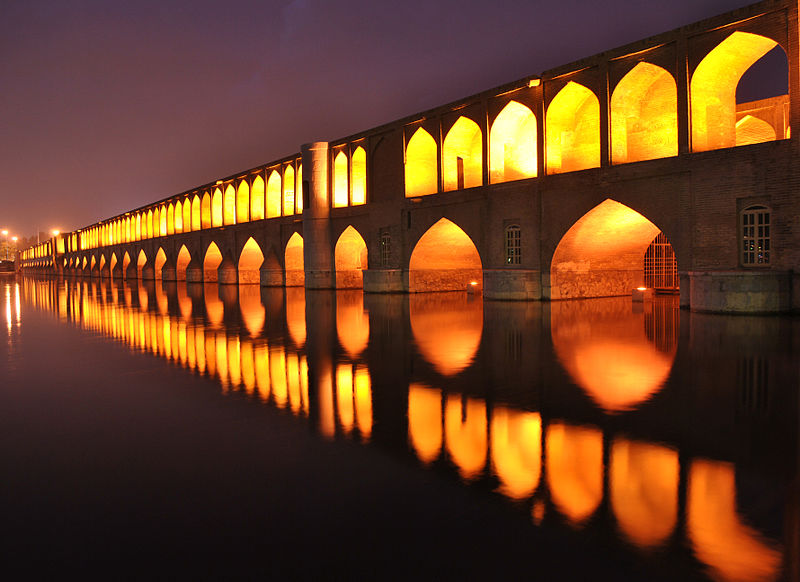Iran is home to one of the world’s oldest civilizations, beginning with the formation of the Elamite kingdoms in the fourth millennium BC.
Alongside the capital, the most popular tourist destinations are Isfahan, Mashhad, and Shiraz. In the early 2000s, the industry faced serious limitations in infrastructure, communications, industry standards, and personnel training.The majority of the 300,000 travel visas granted in 2003 were obtained by Asian Muslims, who presumably intended to visit pilgrimage sites in Mashhad and Qom. Several organized tours from Germany, France, and other European countries come to Iran annually to visit archaeological sites and monuments. In 2003, Iran ranked 68th in tourism revenues worldwide. According to the UNESCO and the deputy head of research for Iran’s Tourism Organization, Iran is rated fourth among the top 10 destinations in the Middle East. Domestic tourism in Iran is one of the largest in the world. Weak advertising, unstable regional conditions, a poor public image in some parts of the world, and absence of efficient planning schemes in the tourism sector have all hindered the growth of tourism.
1. Arg-e Bam
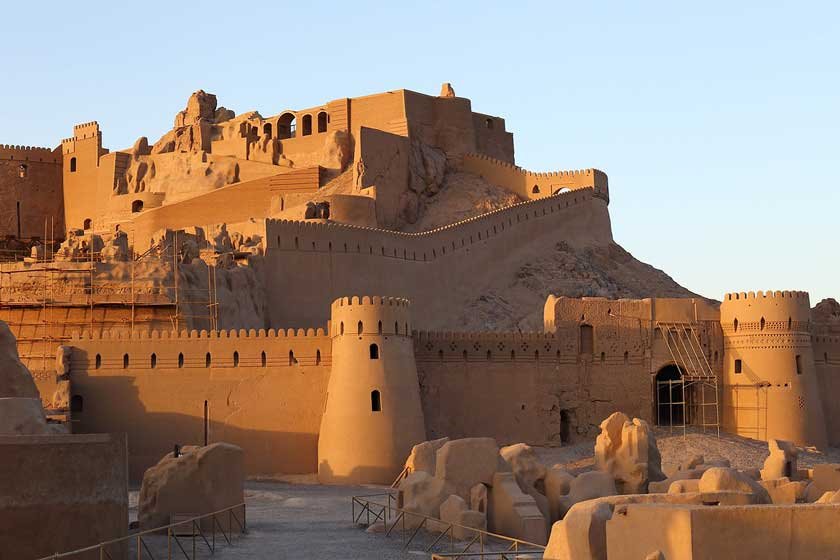
The Arg-e Bam (Persian: ارگ بم), located in the city of Bam, Kerman Province of southeastern Iran, is the largest adobe building in the world. The entire building was a large fortress containing the citadel, but because the citadel dominates the ruins, the entire fortress is now named Bam Citadel.
Listed by UNESCO as part of the World Heritage Site “Bam and its Cultural Landscape”, it can be traced back to at least the Achaemenid Empire (sixth to fourth centuries BC). The citadel rose to importance from the seventh to eleventh centuries, as a crossroads along the Silk Road and other important trade routes, and as a producer of silk and cotton garments.
On 26 December 2003, the Citadel was almost completely destroyed by an earthquake, along with much of the rest of Bam and its environs.
There is no precise archaeological dating of the buildings of the Citadel of Bam. However, through historic sources and ancient texts, the first human settlement in the area can be traced back to the fort built by the Achaemenians, around 579–323 BC. Some of the citadel’s features, such as its establishment on a platform combining a natural hilltop and a manmade terrace, have been compared by archaeologists to the Achaemenian model of Persepolis.
During the Parthian rule, the fort was expanded and became Arg-e-Bam, the Citadel of Bam. A comparative study, titled “Bam and a Brief History of Urban Settlement and Planning in Iran”, concluded that the essential core of the city of Bam and the Governor’s section were built during the Parthian era. Under the Sassanids, the castle was seized by Ardeshir Babakan. New fortifications and walls were constructed between 224 and 637 AD
2.Isfahan

Isfahan is a city in central Iran, known for its Persian architecture. In the huge Naqsh-e Jahan Square is the 17th-century Imam (Shah) Mosque, whose dome and minarets are covered with mosaic tiles and calligraphy. Ali Qapu Palace, built for Shah Abbas and completed in the late 16th century, has a music room and a verandah overlooking the square’s fountains. Sheikh Lotfollah Mosque is known for its intricate tiling .
Bridges
The bridges on the Zayanderud river comprise some of the finest architecture in Isfahan. The oldest bridge is the Shahrestan bridge, whose foundations were built by the Sasanian Empire (3rd–7th century Sassanid era); it was repaired during the Seljuk period. Further upstream is the Khaju bridge, which Shah Abbas II built in 1650. It is 123 metres (404 feet) long with 24 arches, and also serves as a sluice gate.
Another bridge is the Choobi (Joui) bridge, which was originally an aqueduct to supply the palace gardens on the north bank of the river. Further upstream again is the Si-o-Seh Pol or bridge of 33 arches. The building was built during the reign of Shah Abbas the Great by Sheikh Baha’i and connected Isfahan with the Armenian suburb of New Julfa. It is by far the longest bridge in Isfahan at 295 m (967.85 ft).
Another notable bridge is the Marnan Bridge.
Churches and cathedrals
Further information: List of Armenian churches in Iran
Churches in the city are mostly in the New Julfa region. Some of the historically important ones are Bedkhem Church – 1627, St. Georg Church – 17th century, St. Mary Church – 17th century, Vank Cathedral – 1664. The oldest one is St. Jakob Church – 1607.
Gardens and parks
The Pardis Honar Park cost 30 billion toman in District 6 by 2018. Some other zoological gardens and parks (including public & private beach parks, non beach parks) are Birds Garden, Flower Garden of Isfahan, Nazhvan Recreational Complex, Moshtagh, Shahre royaha [fa] amusement park, and the East Park of Isfahan
Minarets
Menar Jonban was built in the 14th century. The tomb is an Iwan measuring 10 meters high. Other menars include Ali minaret – 11th century, Bagh-e-Ghoushkhane minaret – 14th century, Chehel Dokhtaran minaret – 12 century, Dardasht minarets – 14th century, Darozziafe minarets – 14th century, and Sarban minaret.
Museums
Contemporary Arts Museum Isfahan
Isfahan City Center Museum
Museum of Decorative Arts
Natural History Museum of Isfahan
Palaces and caravanserais
Ali Qapu (The Royal Palace) – early 17th century
Chehel Sotoun (The Palace of Forty Columns) – 1647
Hasht-Behesht (The Palace of Eight Paradises) – 1669
Shah Caravanserai
Talar Ashraf (The Palace of Ashraf) – 1650
Cuisine
Gosh-e fil and Doogh is a famous city snack. Other traditional breakfasts, desserts and meals include Khoresht mast, Beryani and meat with beans and pumpkin aush. Gaz & Poolaki are two popular Iranian candy types originating in Isfahan.
3.Shiraz
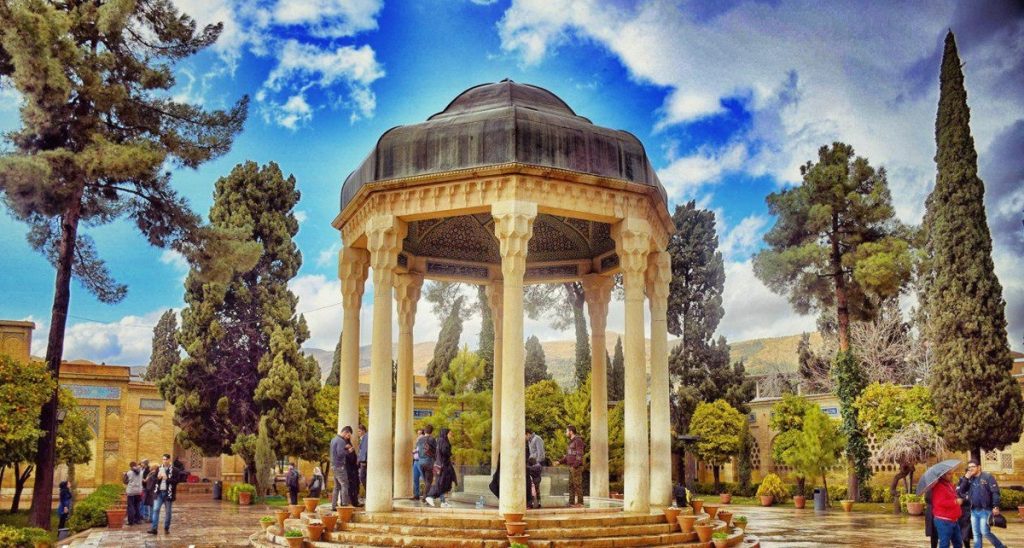
Shiraz is a city in south-central Iran, known for its literary history and many gardens. The marble Tomb of Hafez, honoring the revered poet, sits within its own garden. To the east, the Mausoleum of Saadi houses the 13th-century writer’s mosaic-tiled tomb and an underground pool. Shiraz is a gateway to Persepolis, the ruined 6th-century-B.C. capital to the northeast, with its immense gateways, columns and friezes.
After the Iranian Revolution, Shiraz was re-established as the capital of Iranian Art and Culture among the people. Shiraz is known[by whom?] as the capital of Persian Art, Culture and Literature. However, the current government has tried to re-brand the city as “Sevomin haram-e ahle beit” meaning “Third home of Saints” referring to the Shahcheragh shrine and some other holy places in the city.
The city is one of the key tourism sites in Iran, its cultural heritage is of global importance.
Persepolis was the ceremonial capital of the Achaemenid Empire. It is situated in the plains of Marvdasht, encircled by southern Zagros mountains of Iran. Modern day Shiraz is situated 60 kilometres southwest of the ruins of Persepolis. The earliest remains of Persepolis date back to 515 .
The tombs of Hafiz, Saadi, and Khaju e Kermani (whose tomb is inside a mountain above the city’s old Qur’an Gate). Other lesser known tombs are that of Shah Shoja’ (the Mozafarid emir of Persia, and patron of Hafiz), and the Haft Tanan mausoleum, where seven Sufi mystics are buried. The Tomb of Baba Kuhi sits atop a mountain overlooking the city, and the tomb of Karim Khan Zand is at the Pars Museum of Shiraz.
The oldest mosque is Atigh Jame’ Mosque, which is one of the older mosques of Iran, followed by Vakil Mosque and Nasir al-Mulk mosque. The Vakil Mosque is situated west of the famous Vakil Bazaar. It covers an area of 8,660 square metres (93,200 square feet) and was built in 1187 (AH) during the Zand Dynasty. On the two sides of the entrance gate there are magnificent tile-works and arches. The left and right corridors of the entrance gate are connected to the main room.
The citadel of Arg of Karim Khan sits adjacent to the Vakil Bazaar and Vakil Bath at the city’s central district. The most famous of houses are Zinat-ol-Moluk House and Gahavam’s House, both in the old quarters of the city.
The Qur’an Gate is the entrance to Shiraz. It is located near the gorge of Allah-o-Akbar and is flanked by the Baba Kuhi and Chehel Maqam mountains. The gateway once contained two hand-written Qur’āns by Sultan Ibrahim Bin Shahrukh Gurekani in an upper room, which have now been moved to the Pars Museum.
The Eram Garden (Bagh-e Eram) in Shiraz is a striking location for visitors with a variety of plants as well as a historic mansion. Although the exact date of the construction of the garden is not clear, historical evidence suggests it was constructed during the Seljuk Dynasty on the orders of the celebrated Seljuk monarch Sanjar. Other historical Persian gardens are Afifabad Garden and The Museum of Weapons, Delgosha Garden and Jahan Nama Garden.
Margoon Waterfall is located in the Fars Province of Iran near the city of Sepidan. Its name means in Persian “snake like”.
4.Mashhad
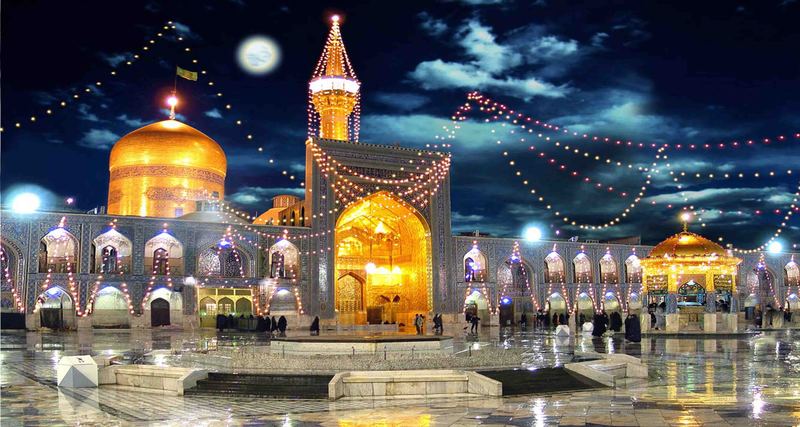
Mashhad is a city in northeast Iran, known as a place of religious pilgrimage. It’s centered on the vast Holy Shrine of Imam Reza, with golden domes and minarets that are floodlit at night. The circular complex also contains the tomb of Lebanese scholar Sheikh Bahai, plus the 15th-century, tile-fronted Goharshad Mosque, with a turquoise dome. Museums within the shrine include the Carpet Museum, with many rare pieces.
The city is named after the shrine of Imam Reza, the eighth Shia Imam. The Imam was buried in a village in Khorasan, which afterward gained the name Mashhad, meaning the place of martyrdom. Every year, millions of pilgrims visit the Imam Reza shrine. The Abbasid caliph Harun al-Rashid is also buried within the same shrine.
Mashhad is Iran’s second largest automobile production hub. The city’s economy is based mainly on dry fruits, salted nuts, saffron, Iranian sweets like gaz and sohaan, precious stones like agates, turquoise, intricately designed silver jewelry studded with rubies and emeralds, eighteen carat gold jewelry, perfumes, religious souvenirs, trench coats, scarves, termeh, carpets, and rugs.
Apart from Imam Reza shrine, there are a number of large parks, the tombs of historical celebrities in nearby Tus and Nishapur, the tomb of Nader Shah and Kooh Sangi park. The Koohestan Park-e-Shadi Complex includes a zoo, where many wild animals are kept and which attracts many visitors to Mashhad.
Some points of interest lie outside the city: the tomb of Khajeh Morad, along the road to Tehran; the tomb of Khajeh Rabi’ located 6 kilometres (3.7 miles) north of the city where there are some inscriptions by the renowned Safavid calligrapher Reza Abbasi; and the tomb of Khajeh Abasalt]], a distance of 20 kilometres (12 miles) from Mashhad along the road to Neishabur. (The three were all disciples of Imam Reza).
Among the other sights are the tomb of the poet Ferdowsi in Tus, 24 kilometres (15 miles) distance, and the summer resorts at Torghabeh, Torogh, Akhlamad, Zoshk, and Shandiz.
5.Tabriz
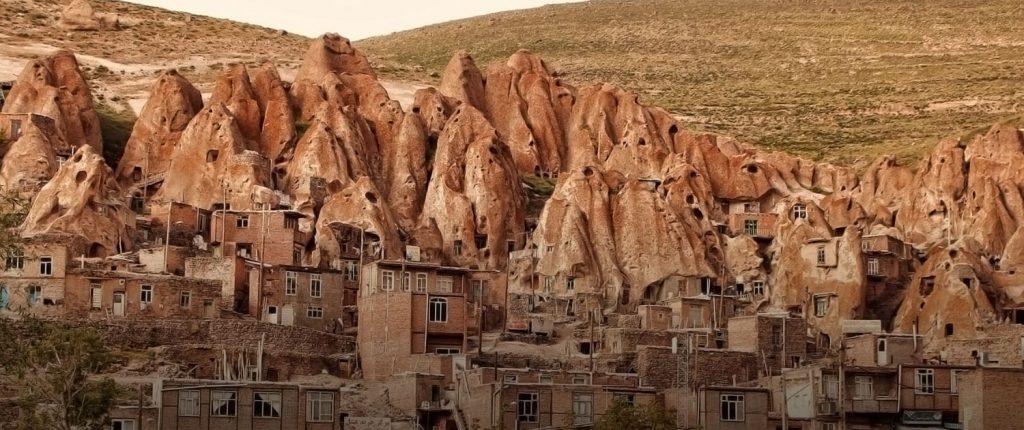
Tabriz is the capital city of East Azerbaijan Province, in northwestern Iran. Tabriz Bazaar, once a major Silk Road market, is a sprawling brick-vaulted complex selling carpets, spices and jewelry. The rebuilt 15th-century Blue Mosque retains original turquoise mosaics on its entrance arch. Collections at the Azerbaijan Museum range from prehistoric finds to 20th-century sculptures by Iranian artist Ahad Hosseini.
Elgoli Park
Southeast of the city center is the expansive, verdant and peaceful Elgoli Park. Popular with Iranian families, the park is a great place to spend a relaxing evening, pick up a street side corn on the cob, picnic with friends, and maybe even play a spot of badminton. Shady and with great views of the city from its highest point, the park surrounds a small lake, at the center of which is a reasonably priced traditional restaurant.
Tabriz citadel
What remains of the Tabriz citadel (arg-e Tabriz) dates back to the 14th century, when it was constructed as a mausoleum under the Ilkhanate dynasty. Re-appropriated as a military compound in the 19th century during the Russo-Persian wars, the structure has a long and varied history. The edifice suffered further damage by Russian shelling in 1911, and only in recent decades has it undergone some renovation work. The imposing stone building is one of the most famous landmarks in Tabriz and is located centrally on Imam Khomeini Street.
6.Tehran
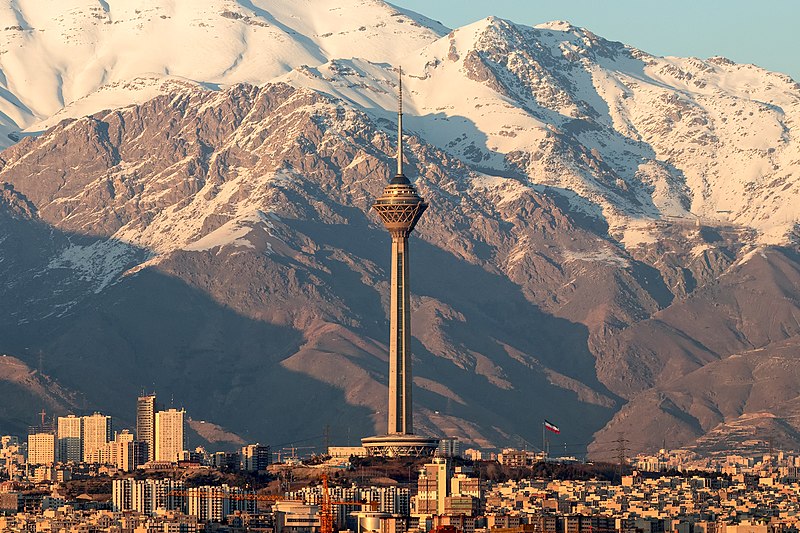
Tehran is the capital of Iran, in the north of the country. Its central Golestan Palace complex, with its ornate rooms and marble throne, was the seat of power of the Qajar dynasty. The National Jewelry Museum holds many of the Qajar monarchs’ jewels, while the National Museum of Iran has artifacts dating back to Paleolithic times. The Milad Tower offers panoramic views over the city.
Tehran is home to many historical locations, including the royal complexes of Golestan, Sa’dabad, and Niavaran, where the two last dynasties of the former Imperial State of Iran were seated. Tehran’s most famous landmarks include the Azadi Tower, a memorial built under the reign of Mohammad Reza Shah of the Pahlavi dynasty in 1971 to mark the 2,500th anniversary of the founding of the Imperial State of Iran, and the Milad Tower, the world’s sixth-tallest self-supporting tower, completed in 2007, and the Tabiat Bridge, completed in 2014.
7.Ramsar
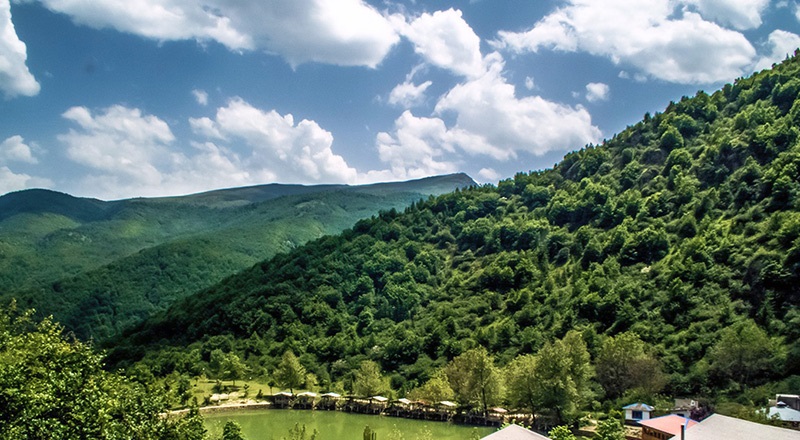
Ramsar is the capital of Ramsar County, Mazandaran Province, Iran. Ramsar lies on the coast of the Caspian Sea. It was also known as Sakhtsar in the past. The climate of Ramsar is hot and humid in summer and mild in winter. The proximity of the forest and the sea in this city has given a special beauty to this city and this attracts tourists in all seasons. Ramsar has an airport. The city of Ramsar was a small village in western Mazandaran until the Qajar period, and during the first Pahlavi period, with the rule of Reza Shah and with the support of the government, it became a beautiful city with many tourist facilities.
Alborz Mountain:
Alborz Mountain is a must visit tourist spot in Ramsar County about 27 kms from Ramsar city centre. It is located at an altitude of 2700 meters in Javaherdeh Village. Summer months are best to trip this stunning mountain.
Ramsar Beach:
Ramsar Beach is visited by plenty of tourists especially from Western countries every year for its marvelous beauty. There are several resorts and restaurants placed in the vicinity of beach.
